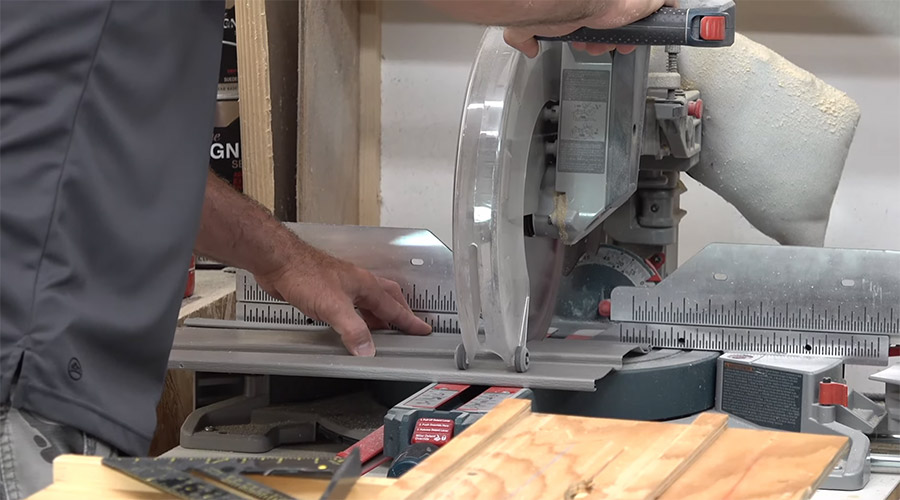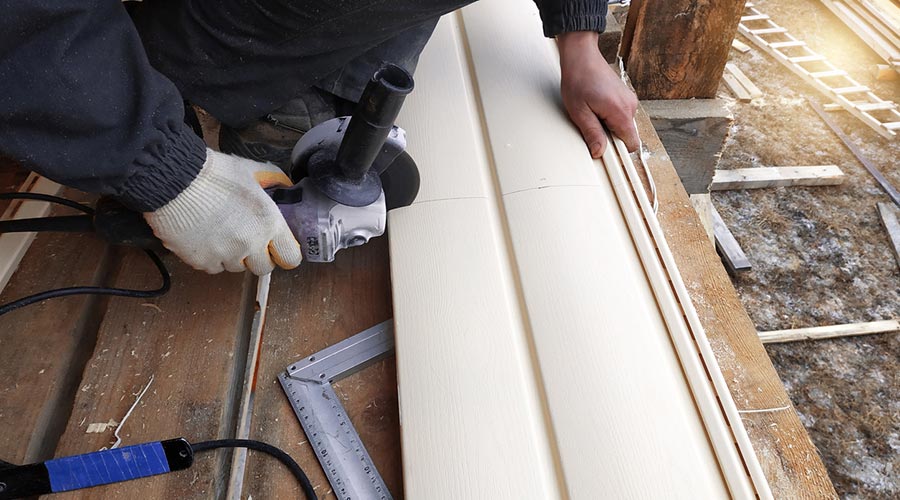
When hanging vinyl siding from J-Channel, you may notice that you have to cut your vinyl to fit it around your house. You will need to shape most vinyl siding to fit under J-Channel. When vinyl siding is under J-channel, it will prevent moisture from being trapped against your drywall.
You can cut vinyl siding in various ways. You can use a circular bench saw, tin snips, and utility knives. If you are cutting vinyl siding with a miter blade, you should reverse the direction of the blade for a smoother cut. You can also cut vinyl siding with an angle grinder.
Read on to discover the best way to cut vinyl siding.
What is the Best Way to Cut Vinyl Siding?
Perfectly cut vinyl sidings can be achieved with the help of a professional. Still, it can also be performed by a regular DIY enthusiast like you and me if you use the right tools and follow the correct procedures.
Here are 5 best ways to cut vinyl sidings, the best tools to use for each method, and a complete how-to guide of how each is done:
1. Gable Cuts Using Circular Bench Saw
You will primarily use the circular saw for straight and gable cuts. Here are the steps to follow when using a bench saw for cutting vinyl sidings:
- Fit it with a fine-toothed plywood-cutting blade
- Wear safety goggles
- If you want the smoothest cuts, put the blade in backward. Additionally, if the blade is in the usual way, the vinyl will get chipped.
- Lie the vinyl siding on a flat table
- The place where you plan to cut it should be hanging off the edge of the table
- Ensure that the siding is making right angles with the table
- While holding a carpenter’s square with the siding, use the circular saw to cut off the excess
Who Makes the Best Circular Bench Saws?
As we’ve mentioned, circular bench saws are for straight and gable cuts. It can also not cut at low angles because it needs to cut across a surface. If you are looking to make a quick straight and gable cut, here are 3 saws that might work for you:
1. Milwaukee 2732-20 M18 Fuel Cordless Circular Saw
- No difference in cutting between this one and the more recent M18 rear handle circular saw
- Sawdust deflects to the right
- An efficient dust collection system
- Right handle
The Milwaukee 2732-20 M18 appears to have a power issue. It will cut out if using full-depth, full-length material. However, this will not come into play unless you cut multiple vinyl siding sheets at once.
2. DeWalt DWE575SB Sidewinder Circular Saw
- Corded
- It has an electric brake
- It comes with a contractor’s bag, and an 18-tooth circular saw blade
- Its rugged cord system reduces the risk of accidental disconnection from power
- Includes a slot that makes it convenient to change the blade
- Easy to adjust
- Built-in ejection port ensures that your line of sight remains clear
As always, you should be sure to reverse the blade of your saw when you use it.
How Do You Cut Vinyl Siding with a Skill Saw?
There is no difference between a skill saw and a circular saw. Skill is a company that makes circular saws. Its namesake later became skill saw. Circular saws are therefore no different than skill saws.
You should follow the same procedure for cutting vinyl siding with a circular saw. Remember to reverse the saw blade so it is pointing up. You will use these saws for straight cuts.
2. Smooth Cuts Using Tin Snips
Perhaps the most mobile tools, tin snips, are portable and look just like scissors. For the smoothest cuts, the snips should not be closed all the way when cutting.
With metal siding, you would have to alternate the color of your snips; however, you only need one pair of tin snips when cutting vinyl siding. Follow these steps to cut vinyl siding with tin snips:
- Mark your line where you need to cut
- Place the siding on a work table with the part of the siding you plan to cut off hanging slightly off the table
- Use a carpenter’s square to set it perpendicular to the table
- Close the tin snips about two-thirds of the way while cutting
- Press the snips forward if they didn’t slice the siding all the way through
- Keep cutting until the excess drops to the floor
Who Makes the Best Tin Snips?
Tin snips are great for angled cuts and can be used to shape the edges of vinyl siding in ways that many straight-edged blades cannot. Many experts recommend the same type of tin snips:
Crescent Wiss 9-3/4 Inch MetalMaster Compound Action Snips
- It cuts 8 miles of steel
- Aviation Snips
- Easy-to-use finger trigger spots
- Locking Mechanism
- Spring-loaded
- Straight cut
- It comes with a Toolbelt loop
Since steel is not as hard to cut as vinyl, your snips will likely exceed their warranty if you use it only on vinyl.
3. Small Cuts Using Utility Knife
Finally, the utility knife is the second-most mobile of the group. It is lightweight, easy to carry, and can make small and straight cuts. It is best to use a utility knife with a blade that does not jiggle when pressing it against a flat surface. You should test this before cutting. Follow these instructions to cut vinyl siding:
- Place the siding face-up on the work table
- Use a straightedge to mark where you will slice it
- Using medium pressure, score along the straightedge
- Bend the strip along the cut line and snap it
- If it doesn’t break apart, bend it forward and backward until it does
Who Makes the Best Utility Knives?
Utility knives are great for cutting off short pieces of vinyl, which you will do after you cut a piece off of a larger sheet with a circular saw or angle grinder. Experts mainly recommend 3 utility knives:
1. Gerber EAB Pocket Utility Knife
- Stainless Steel
- It makes opening boxes easy
- Easy to remove and replace the blade
- Pocket clip works as a cash clip
- You can open it with one hand
- Small and compact
- Good for simple tasks
However, the Gerber EAB Pocket Utility Knife is hard to use for repetitive tasks because it will hurt your hand due to repetitive stress.
2. Stanley 10-099 6 in Classic 99 Retractable Utility Knife
- Basic utility knife
- One cent cheaper than the non-retractable version
- It comes with three blades
- Easy to slide but clicks every time you shift
- If there are extra blades, you will hear them
- Durable
- Solid
However, it is not easy to access the blade storage on the knife, and it is less precise than the non-retractable version.
3. Alltrade 150003 Auto-Loading Squeeze Utility Knife
- Squeeze the lever to retract and extend
- Does not need a knife to open the product
- Hefty
- Grips for fingers
- Easy to change the blade
- Built-in blade holder
Caution: It is possible to hit the retraction switch and accidentally retract the blade while cutting your vinyl siding.
4. Straight Cuts Using Miter Saw Blade
A miter saw is a type of stationary saw. Many recommend that you should reverse the saw blade. If the blade is pointing down, you could crack the siding. It might also rip the vinyl siding if the blade is 12″ long or longer. Finally, you use the miter saw for straight cuts.
Lower the saw blade to the vinyl and move straight.

5. Rough Cuts Using Angle Grinder
You can cut vinyl siding with an angle grinder. A slice from an angle grinder will result in a rough cut. It will also result in a static, plastic dust cloud. Finally, there will be imperfections that you can fix by hand. These imperfections include a lip on the plastic.
It would be best if you used the correct wheel to cut the vinyl siding with an angle grinder neatly. Vinyl is plastic, which means that it can melt. If you use the incorrect wheel, the vinyl can melt from the grinder’s heat. Therefore, a ceramic, covered wheel will work the best.
Who Makes the Best Angle Grinders?
While not ideal for cutting vinyl siding, angle grinders will come in handy if you can get away with a rough cut and then fix any imperfections by hand. Experts typically recommend 3 angle grinders:
1. Makita 9557PBX1 4-1/2-Inch Angle Grinder
- Masonry Blade could grab and shut off quickly
- Its performance doesn’t suffer even after it does heavy work
- Easy to handle
- It comes with two rigid metal diamond cutting blades
- It comes with a durable case
However, the Makita sometimes comes with a manufacturing defect. The company will honor its warranty. Additionally, the masonry blade could grab and cut off quickly. Finally, you must remove the handle to put it in the case.
2. DEWALT DWE402 Angle Grinder
- More power than the average grinder
- Good handle
- Hefty
- You can change the grinding heads with an allen wrench
- Easy-to-adjust guard
- Reversible lug
- Hard to bog down when grinding metal
However, quality control has forgotten to remove stickers on the outlet prongs. There is also not much difference in performance compared with other DeWalt angle grinders when cutting metal.
3. BLACK+DECKER BDEG400 6 Amp Angle Grinder
- Easy-to-adjust guard
- Cannot twist the position of the handle so that the switch is on the top
- Not padded
- Three different places for the handle
- Weak material on the cord
- Wire kink preventer is not flexible
- It doesn’t run as smoothly as high-end grinders
As you may have guessed, the Black+Decker is the budget angle grinder. You cannot twist the position of the handle so that the switch is on the top. It has no padding. The power cord material is not durable, and the wire kink preventer is not flexible. Finally, it doesn’t run as smoothly as high-end grinders.
What are the Most Useful Tools for Cutting Siding?
Saws, knives, snips are still great tools to use if you’re cutting other types of sidings aside from vinyl. See the chart below for the tools and their functions:
| Tool | Functions | Notes |
|---|---|---|
| Power Saw | Used to cut the siding or soffit | Cannot cut low angles |
| Utility Knife | Used for cutting, trimming, and scoring | Prevents cut lines |
| Tin Snips | Used for cutting and shaping Used to cut specific angles | |
| Snap Lock Punch | Used to punch lugs in siding used at the top of the wall or underneath a window Used to widen J-channel tab projections | |
| Nail Hole Slot Punch | Used to elongate a nail hem slot | Elongates and adds nail holes for irregular spacing |
| Zip Lock Tool | Used to remove or replace a siding panel | Known as a “zip tool” or a “sideswiper” Slide the lip underneath the siding panel you want to switch out and move it across To undo, slide it underneath the lip of the siding, and drag it across while pressing down |
5 Tips for Cutting and Installing Vinyl Siding
1. Include Doors and Windows in Your Measurements
When measuring how much siding you need to do the job, make sure that you include the square footage that any doors and windows take up on your exterior. It is always a good idea to have that bit of extra material in case of any errors with your calculations.
2. When Doing a DIY Vinyl Siding Project Ask a Friend to Help
Don’t attempt to install the siding by yourself. At least two people are required to hold and hang the long, flexible pieces of vinyl siding. Trying to do the job alone may result in injury or damaged materials.
This is particularly important when working overhead or on a ladder.
3. Cut the Sidings 1/4 Inch Shorter in Winter
During the fall or winter months, when cutting vinyl siding to fit into a corner, be sure to make the piece a tiny bit shorter than the exact length required; a minimum of ¼ inch is recommended. In the warmer weather, vinyl siding will expand and buckle if it does not have adequate space to expand.
By trimming a bit extra off the siding, you’ll prevent the vinyl siding from forming ripples or buckling as it expands during the summer.
4. Turn the Saw Blade Around on Bench, Circular or Miter Saws
When cutting angles into vinyl siding with a bench, circular, or miter saw, turn the saw blade around to prevent jagged cuts. By turning the blade around, you’ll prevent the saw from damaging the edges of the vinyl siding.
5. Allow Space for the Vinyl Siding to Move
Just as important as the cutting of vinyl siding, avoid nailing vinyl siding too tightly. It would be best if you place the nail in the center of the nail flange space and don’t sink the nail head to allow the siding room to expand during the summer heat.
Final Thoughts
You can use different tools to cut vinyl siding. You will make the roughest cut with an angle grinder and the smoothest cut with tin snips. Meanwhile, the circular or skill saw will work for gable cuts. Finally, you can use the utility knife to make cuts, trims, and scores without leaving cut lines.







